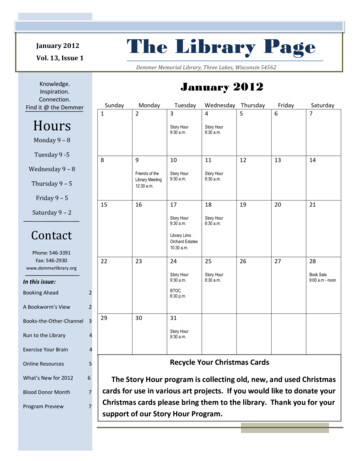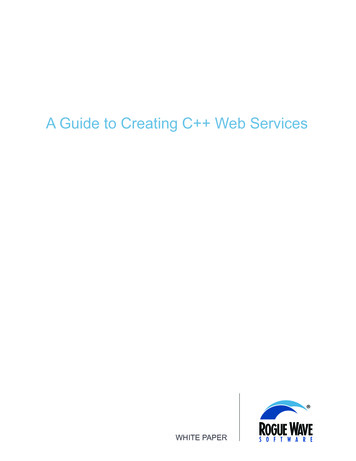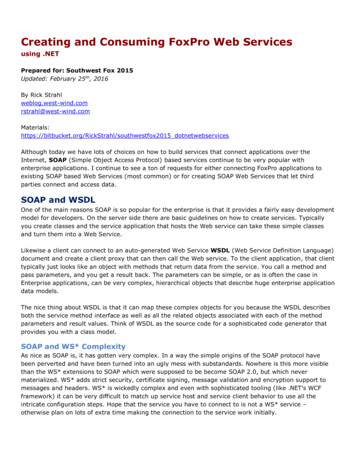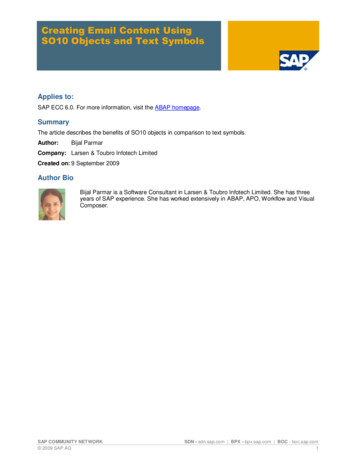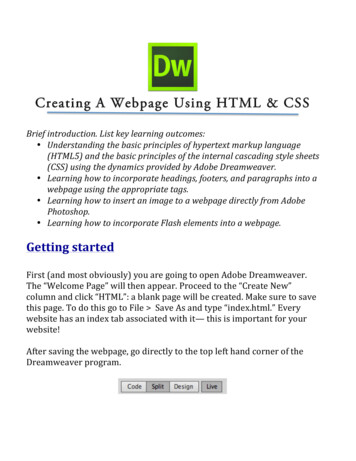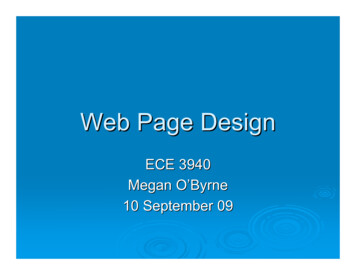
Transcription
Creating a Web Page Using HTML, XHTML, and CSSModule 6Creating a WebPage Using HTML,XHTML, and CSS:The BasicsMary L. Lanigan, Ph.D.Copyright 2010 Third House Inc.1
Creating a Web Page Using HTML, XHTML, and CSSModule 6PrefaceIn this module, you will create a web page. The web page will look like a mini-resume.After completing all the exercises within this module, your page will look something likethe example on the next page.Please Note: This document is best viewed eitheron a computer screen or printed out by a colorprinter.It is also recommended that you print out thecodes for the example web page. The codes arefound on Module 6-3. Click the link immediatelyfollowing the link for this job aid.Copyright 2010 Third House Inc.2
Creating a Web Page Using HTML, XHTML, and CSSCopyright 2010 Third House Inc.Module 63
Creating a Web Page Using HTML, XHTML, and CSSModule 6Exercise 1: Using a BrowserIn order to create a web page, you need to be familiar with a browser. There are a numberof browsers available-- the two most common are Microsoft Internet Explorer andMozilla Firefox. It is recommended that you use Explorer to complete this module inorder to reduce confusion. Some browsers do not contain all the necessary options tocomplete the exercises within this module. Thus, it is critical you use Explorer.Step 1:Open your browser by clicking the appropriate icon on yourcomputer.Step 2:After the browser opens, notice a few things.A.The Address box.This box is where you type in the URL of any web page youare searching for. The box also lists the address of the page youare presently on.B.Under File, click Open; click Browse.Browsebrings up thisbox so youcan find thefile you wishto open.Copyright 2010 Third House Inc.4
Creating a Web Page Using HTML, XHTML, and CSSModule 6When you create web pages, sometimes you may elect to open the file by clicking thebrowse button. By doing so, you don’t have to be connected to the Internet to view thesefiles. For now, close your browser and proceed to the next exercise.Exercise 2: Creating a Data SheetPrior to building a web page, you are asked to create a data sheet. The data sheetinformation will be used to create your Internet homepage. This step is not required tocreate web pages; however, it is needed to complete this module's exercises.Step 1:Open Word.Step 2:Create a data sheet that includes your: name; an overview of work accomplishments; work address; professional experiences; educational background; and, additional information you wish people to know about you.Please Note: This information will be posted on the Internet for all tosee. Only use information you are willing to make public and that isprofessional.Copyright 2010 Third House Inc.5
Creating a Web Page Using HTML, XHTML, and CSSModule 6Data Sheet ExampleMary L. LaniganDr. Lanigan is a four-time ISPI Award of Excellence winner for her evaluation research (1999), book (2001) andCD training workshops (evaluation CD in 2005 and performance technology CD in 2007). As an AssociateProfessor at Governors State University, she teaches various performance improvement classes and is the recipientof three Faculty Excellence awards. Dr. Lanigan has presented papers at national and regional conferencessponsored by the International Society of Performance Improvement and the American Society of Training andDevelopment. She has written articles for Performance Improvement, Performance Improvement Quarterly, TheJournal of Insurance Trainers and Educators, and the International Journal of Intercultural Relations. Her doctorateis from Indiana University, specifically, the Instructional Systems Technology program and her Masters degreesare in Educational Psychology, Communication, and Instructional Systems Technology.Address:Department of Communication & TrainingCollege of Arts and SciencesGovernors State UniversityUniversity Park, Illinois 60466Professional Experiences:Professor/Governors State UniversityTrainer/Publishers Circulation FulfillmentTrainer/First Midwest BankEducational Background:Ph.D., Instructional Systems Technology, Indiana UniversityM.S., Instructional Systems Technology, Indiana UniversityM.S., Educational Psychology, Indiana UniversityM.S., Communication, Illinois State UniversityB.A., Speech Communication, University of Illinois, Champaign-UrbanaImportant Links Regarding Performance ImprovementTo learn more information about earning a degree in instructional design and training (also known as performanceimprovement or performance technology), click on the links below.To obtain specific information such as class syllabi, plan of study examples and more, then go to: HumanPerformance and TrainingTo obtain specific information about admissions and fees, then go to: Governors State UniversityPerhaps a video on instructional design can be inserted.Top five things you should know about performance technology: The goal of the field is to raise employees' performances to optimal levels. To determine if the goal has been met, performance technologist must compare the benchmarks ofoptimal performance to what is actually happening on the job. After comparing the benchmarks to actual performance, performance technologists determine gaps,causes, and solutions. The solutions implemented will be training and/or non-training interventions. All interventions are evaluated and matched back to the benchmarks to see if the solutions enhancedemployees' performances back to optimal levels. If you have questions about the field or the graduate program at Governors State University, contact Dr. Lanigan.Copyright 2010 Third House Inc.6
Creating a Web Page Using HTML, XHTML, and CSSStep 3:Save the data sheet you created.Step 4:Minimize the window.Module 6Exercise 3: Constructing a Web PageWhat are HTML, XHTML, and CSS Coding?Hypertext Markup Language (HTML) is the coding that aids browsers in reading onlinedocuments. Extensible Hypertext Markup Language (XHTML) is a stricter variation ofHTML, which mandates certain rules for all web designers. For example, in the pastwhen web designers only used HTML, they were able to write code both in upper andlower case letters. Now with XHTML that is no longer the case. Web designers mustwrite code all in lower case. CSS are style sheets that describe the web page colors,fonts, and more. For this module, we will be predominantly using XHTML and CSScoding.To see what web source code looks like, go to any web page on the Internet. In theInternet Explorer browser: click View; click Source. For the debrief below, use the codesfrom my web page example that I asked you to print out on page 2 of this document.The top code on a source pagetypically indicates the XHTMLversion. Notice that the top codealso indicates that this web pageis in compliant withwww.w3.org, which is aconsortium whose goal is tocreate consistency for all webdesigners.Next, the head section includesthe title and styles.The CSS styles listed include themargin size, body fonts,background color, and more.Scroll down the source codepage until you see these codes: /style /head body Copyright 2010 Third House Inc.7
Creating a Web Page Using HTML, XHTML, and CSSModule 6The closed style and headtags /style and /head are telling the browser thatthe style section andheading section are nowclosed.The open body tag body tells the browser that thebody, which contains thewritten content of the website, is now starting.The words written in blacktext are the actual wordsthat appear on the webpage. The words written inblue and red are theXHTML and HTML codes.Things You Need Prior to Creating Your Web PageYou are going to create a web page using HTML, XHTML, and CSS codes. Beforebeginning this exercise you need to complete the following steps.1. You are going to create your web page using Notepad , which is NOT theNotepad that is under the Accessory folder on your computer. Instead it isadvanced software that indicates the code in the red and blue colors. In regularNotepad, all contents and coding are in black; this makes coding more difficult.To download Notepad , go to: /For more information about the company that produces Notepad , go 2. You will also need a picture of yourself that has been saved as a .jpg image.3. Create a folder on your hard drive and call it htmlexercise and put your picture inthis folder. You will also be saving your code and anything else you put on yourweb site in this folder.Once you have completed the above three steps you are ready to begin coding.Copyright 2010 Third House Inc.8
Creating a Web Page Using HTML, XHTML, and CSSModule 6Writing CodeRemember, the end result of this exercise is to create a web page that looks similar to theexample on the Preface pages of this module. The only difference is you will besubstituting your information and images for mine.Step 1:Open Notepad .You should see a blank screen.Step 2:Type the following information into your Notepad document.Type it exactly as it appears below. You can also follow along from thecoding source page you printed out earlier.The above information is the Document Type Definition, which indicatesto the browser the type of document it is; the XHTML version; and, thelanguage the designer is using. In this case, the language English (en).Step 3:Next, you are going to type the head information. The heading containscoding that does NOT appear on the web page. Similar to the DocumentType Definition section, it communicates information to the browser. Inthe example below, it is communicating: the content type; and, the title of the web page.Go ahead and type the code exactly as you see it, including the meta andcontent tags and information.Copyright 2010 Third House Inc.9
Creating a Web Page Using HTML, XHTML, and CSSModule 6The title is very important because the browser uses this information whenusers search for web sites. For example, if someone did a Google searchon Mary’s Homepage, then this page would be on the top of the searchresults. As such, you may want to title your page with your first and lastname.Note: Notice how the title has an open title tag and a closed title tag.Open tagClosed tagAlmost all XHTML coding has open and closed tags such as this. If youforget to open or close a tag, then errors will occur in your web page.Notice: We have an open head tag but we have not closedit yet because we are still working in the heading section.Copyright 2010 Third House Inc.10
Creating a Web Page Using HTML, XHTML, and CSSModule 6Here are some examples of open and closed tags.TagsPurpose head /head To create and end a heading. title /title To indicate a page title beginning andending. body /body To indicate the body of the documenthas begun and then to indicate it is ending. h1 /h1 This indicates that you want a group of textto be written in the first heading level. Thisis the largest heading possible. h2 /h2 This indicates that you want a group of textto be written in the second heading level. p /p To begin and end a paragraph. a href “filename” /a This code indicates a link to another file. ol li / li /ol Creates an ordered list. ul li / li /ul Creates an unordered list.Copyright 2010 Third House Inc.11
Creating a Web Page Using HTML, XHTML, and CSSStep 4:Module 6Following the title you want to complete the heading section by putting inall these CSS codes. Type the codes in as illustrated and then I’ll explaineach.Copyright 2010 Third House Inc.12
Creating a Web Page Using HTML, XHTML, and CSSCopyright 2010 Third House Inc.Module 613
Creating a Web Page Using HTML, XHTML, and CSSModule 6NOTE: You have just embedded your styles into your web document. Style sheets canbe internal such as the one you just created or external. External style sheets reside intheir own files (that end with .css). If you were using an external style sheet, you wouldnot put in all those style codes into your web page. Instead you would create a link to theexternal style sheet.For example: link rel "stylesheet" href "./generalLayout.css" type "text/css" / Copyright 2010 Third House Inc.14
Creating a Web Page Using HTML, XHTML, and CSSModule 6Let’s review the internal style codes that you entered into your web page.Notice that we started the section with: style type ”text/css” . This code tells thebrowser that from the open style tag to the closed style tag, we are communicating stylecodes.Whenever you see /* and */ between text that is a statement or note to the web designer.In other words, if you want to write a reminder to yourself, but you don’t want thebrowser to read it, then you can type in words as long as you bookend the wording with/* and */.For example: /* Global Styles Defined */This is just a note to the web editor that the styles are being defined below.Whenever you indicate a style, you begin the code with a { and end it with a }.For example: *{padding:0;margin: 2;}This style is communicating to the browser that there is no padding property around thefour sides of the web page; hence, padding:0. But we are giving margin space or whitespace around the border at a 2.Note: A web page consists of a larger box called a margin. Inside that box is an inner boxcalled a border. Inside the border is a smaller box called the padding.Copyright 2010 Third House Inc.15
Creating a Web Page Using HTML, XHTML, and CSSModule 6Our next style code is defining the body of the web page.For example:body {font-family: Arial, Helvetica, sans-serif; /*Note: this line tells the browser the order tosearch for fonts*/font-size: 1em;line-height: 1.25em;color: black;background-color: #ccccff;height: 100%;}Here we are telling the browser to look for the Arial font first to display the body text. Ifthe browser can’t find Arial, then it will look for Helvetica next and any sans-serif fon
What are HTML, XHTML, and CSS Coding? Hypertext Markup Language (HTML) is the coding that aids browsers in reading online documents. Extensible Hypertext Markup Language (XHTML) is a stricter variation of HTML, which mandates certain rules for all web designers. For example, in the past when web designers only used HTML, they were able to write code both in upper and lower case letters. File Size: 1MBPage Count: 36
